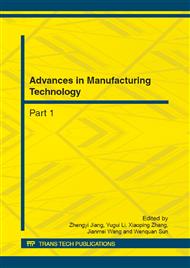p.1588
p.1592
p.1598
p.1602
p.1606
p.1611
p.1615
p.1619
p.1625
Control System Construction of Orchard Transport Test Platform Based on PLC
Abstract:
In order to solve the problems about testing and analysis for the optimization problem of the mountain orchards transport aircraft operating parameters and structural parameters, we build a transport aircraft control test platform. According to actual needs, for complete the circuit design,select the appropriate frequency conversion motor, frequency converter, PLC, and other critical hardware.Using fuzzy PI controller, in the Step-7 authoring environment to compile, complete the PLC programming design; Complete interface design in the in Eviews editing software EV500.After constantly adjust, in conditions for a variety of conditions like stoping in an emergency, an emergency starter, speed transient change, instantaneous change of goods bias, cargo rolling random, the system can be stable operation, uniform speed, experimental platform vibration is very small, the vibration of the truck itself is also very small,which can meet the test requirements enoughly.
Info:
Periodical:
Pages:
1606-1610
Citation:
Online since:
November 2012
Authors:
Price:
Сopyright:
© 2012 Trans Tech Publications Ltd. All Rights Reserved
Share:
Citation:


